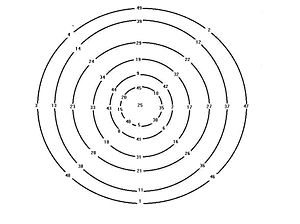- Magic circle (mathematics)
-
 Yang Hui's Magic Circle
Yang Hui's Magic Circle
Magic circles were invented by the Song Dynasty (960–1279) Chinese mathematician Yang Hui (c. 1238–1298). It is the arrangement of natural numbers on circles where the sum of the numbers on each circle and the sum of numbers on diameter are identical. One of his magic circles was constructed from 33 natural numbers from 1 to 33 arranged on four circles , with 9 at the center.
Yang Hui magic circles
Yang Hui's magic circle has the following properties
- The sum of the numbers on four diameters = 147,
- 28 + 5 + 11 + 25 + 9 + 7 + 19 + 31 + 12 = 147
- The sum of 8 numbers plus 9 at the center =147;
- 28 + 27 + 20 + 33 + 12 + 4 + 6 + 8 + 9 = 147
- The sum of eight radius without 9 =magic number 69: such as 27 + 15 + 3 + 24 = 69
- The sum of all numbers on each circle (not including 9) = 2 × 69
- There exist 8 semicircles, where the sum of numbers = magic number 69; there are 16 line segments(semi circles and radii) with magic number 69, more than a 6 order magic square with only 12 magic numbers.
Yang Hui's magic square was published in his Xugu Zhaiqi Suanfa《續古摘奇算法》 (Sequel to Excerpts of Mathematical Wonders) of 1275.
Ding Yidong magic circles
Ding Yidong was a mathematician contemporary with Yang Hui, in his 6th order magic circle with 6 rings, the 5 out rings have connection with a 3rd order magic square: the unit number of the 8 numbers on any ring form a 3rd order magic square.
4 9 2 3 5 7 8 1 6 Method of construction:
- Let radial group 1 =1,11,21,31,41
- Let radial group 2=2,12,22,32,42
- Let radial group 3=3,13,23,33,43
- Let radial group 4=4,14,24,34,44
- Let radial group 6=6,16,26,36,46
- Let radial group 7=7,17,27,37,47
- Let radial group 8=8,18,28,38,48
- Let radial group 9=9,19,29,39,49
- Let center group =5,15,25,35,45
Arrange group 1,2,3,4,6,7,9 radially such that
- each number occupies one position on circle
- alternate the direction such that one radial has smallest number at the outside, the adjacent radial has largest number outside.
- Each group occupies the radial position corresponding to the number on the Luoshu magic square, i.e., group 1 at 1 position, group 2 at
2 position etc.
- Finally arrange center group at the center circle, such that
- number 5 on group 1 radial
- number 10 on group 2 radial
- number 15 on group 3 radial
...
- number 45 on group 9 radial
References
- Lam Lay Yong: A Critical Study of Hang Hui Suan Fa 《杨辉算法》 Singapore University Press 1977
- Wu Wenjun (editor in chief), Grand Series of History of Chinese Mathematics, Vol 6, Part 6 Yang Hui, section 2 Magic circle (吴文俊 主编 沈康身执笔 《中国数学史大系》 第六卷 第六篇 《杨辉》 第二节 《幻圆》) ISBN 7-303-04926-6/O
Categories: - The sum of the numbers on four diameters = 147,
Wikimedia Foundation. 2010.

